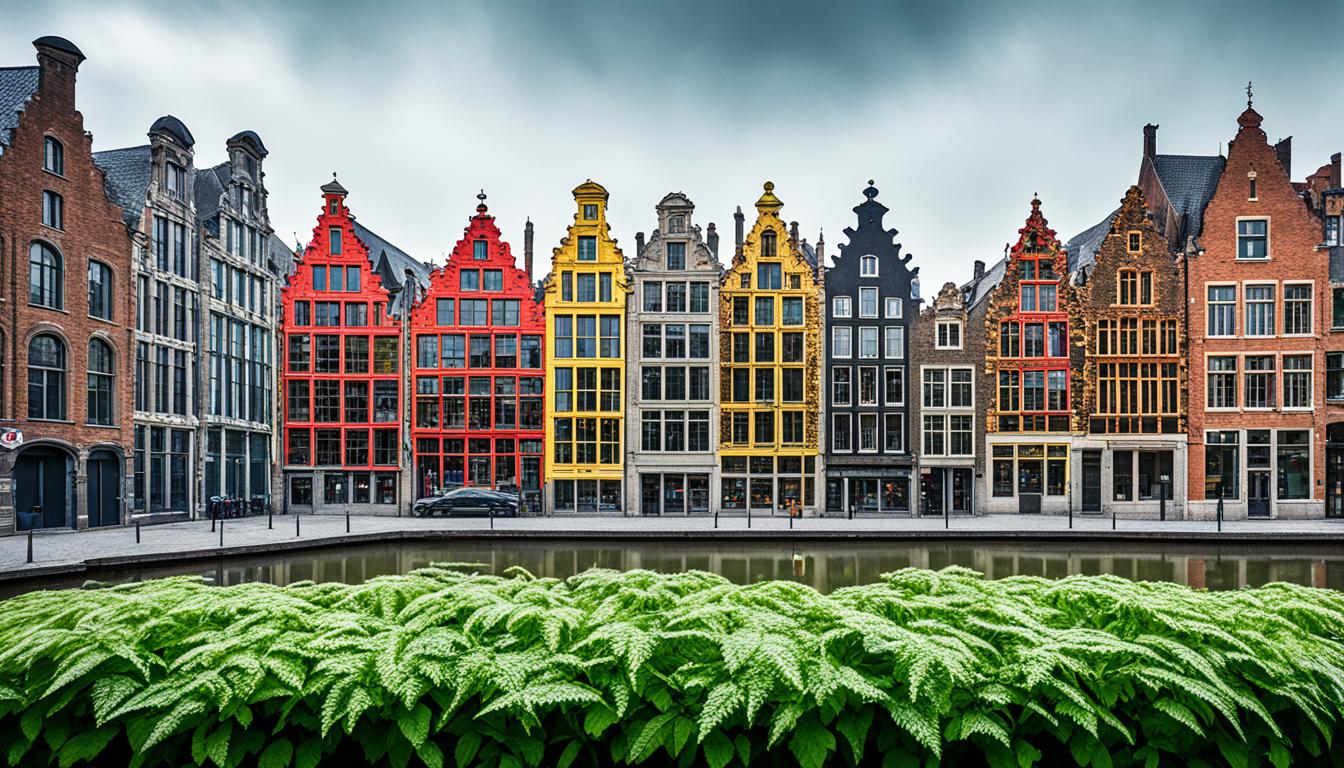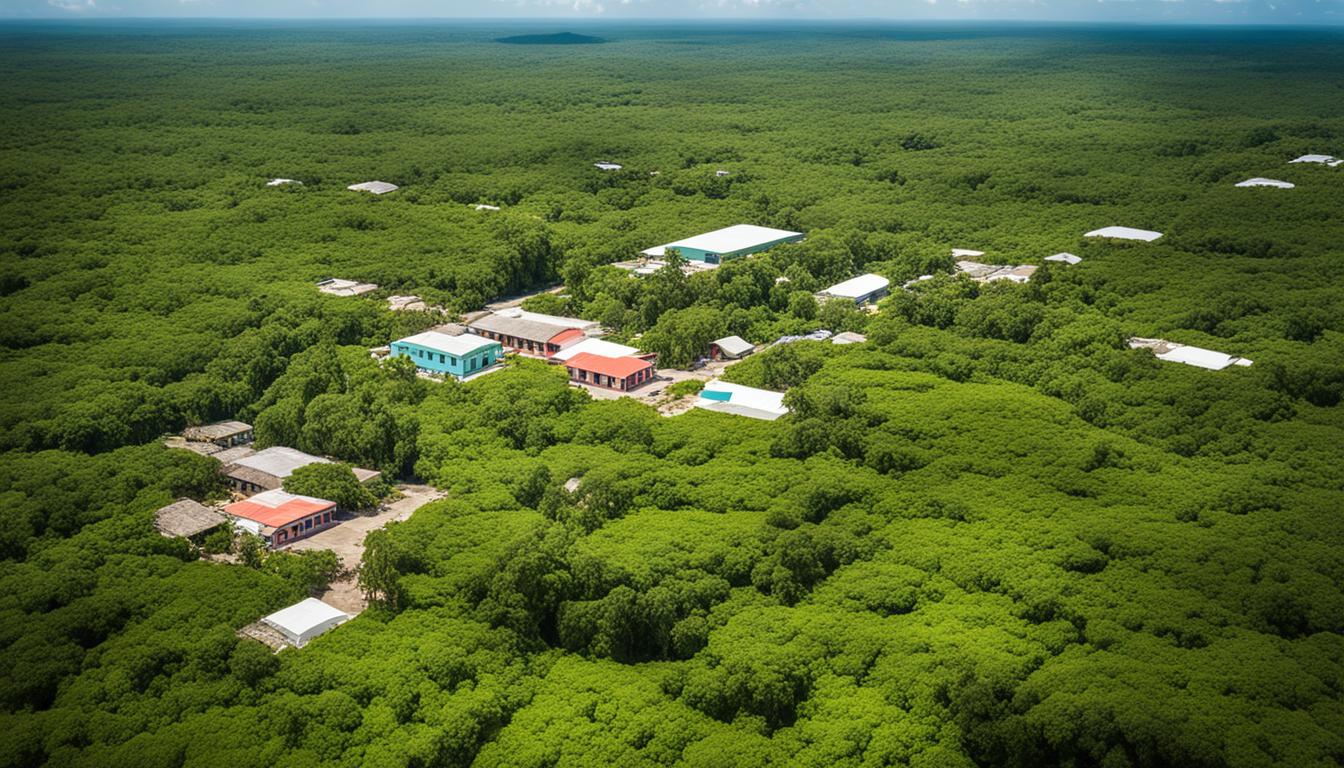Benin Biodiversity and the Built Environment
Benin, located in Western Africa, is renowned for its rich biodiversity and diverse animal and plant species. The country’s flora and fauna make it a crucial hotspot for wildlife conservation. However, Benin’s biodiversity faces numerous threats, including deforestation, habitat loss, and overexploitation of natural resources. In response to these challenges, Benin has embarked on various conservation projects and initiatives to preserve its unique biodiversity and promote sustainable development.
One of the key aspects of biodiversity preservation in Benin is sustainable architecture design and urban planning. By incorporating eco-friendly construction practices, such as the use of locally sourced materials and resource-efficient techniques, Benin aims to minimize the environmental impact of urban development while creating harmonious spaces for both humans and wildlife. Additionally, the development of urban green spaces and the implementation of environmental impact assessments in urban areas contribute to the conservation of biodiversity and the overall well-being of communities.
Key Takeaways:
- Benin is renowned for its rich biodiversity and plays a crucial role in wildlife conservation.
- Deforestation, habitat loss, and overexploitation of natural resources pose significant threats to Benin’s biodiversity.
- Conservation projects and initiatives focus on preserving biodiversity and promoting sustainable development.
- Sustainable architecture design and urban planning contribute to biodiversity preservation in Benin.
- Eco-friendly construction practices, urban green spaces, and environmental impact assessments are essential components of biodiversity conservation in urban areas.
Continued efforts and awareness about the significance of biodiversity preservation are crucial for the future of Benin’s environment and communities.
The Importance of Riparian Forests in Benin’s Biodiversity
Riparian forests in Benin play a crucial role in supporting the country’s biodiversity. They provide habitat for numerous plant and animal species and contribute to the overall ecological balance.
“Riparian forests are vital ecosystems that serve as corridors for wildlife movement and promote genetic diversity,” says Dr. Amina Gado, a renowned ecologist.
These forests act as natural boundaries along rivers and streams, and their unique position allows for the sustenance of diverse flora and fauna.
Unfortunately, riparian forests in Benin are facing significant threats, including deforestation, habitat loss, and the overexploitation of non-timber forest products. Deforestation, in particular, is a major concern as it disrupts the delicate balance of these ecosystems.
According to a recent study conducted by the Benin Environment Agency, over 30% of riparian forests have been lost due to unsustainable agricultural practices and the expansion of human settlements.
The Impact on Endangered Species
The destruction of riparian forests has severe consequences for endangered species that depend on these habitats for survival. Species such as the West African chimpanzee, African elephant, and Nile crocodile are among those at risk due to habitat loss and fragmentation.
“Conservation efforts are urgently needed to protect the rare and endemic species that rely on riparian forests,” emphasizes Dr. Gado.
Conservation Efforts and Restoration Projects
Recognizing the significance of riparian forests, several conservation organizations and government agencies are actively engaged in efforts to protect and restore these habitats. The Benin National Biodiversity Agency, in collaboration with international partners, has initiated projects focused on reforestation, community engagement, and sustainable land management.
“Community involvement plays a crucial role in the success of riparian forest conservation,” explains Dr. Olivier Agossou, a conservation biologist.
One such project, the Riparian Forest Conservation Initiative, aims to raise awareness among local communities about the importance of these forests and promote sustainable practices to mitigate habitat loss.
A Call for Action
Preserving riparian forests in Benin is vital not only for the conservation of endangered species but also for maintaining the overall health and resilience of ecosystems. By protecting these forests, we can safeguard the biodiversity they support and secure the ecological services they provide.
The image above showcases the majestic beauty of Benin’s riparian forests, highlighting the need for their preservation to ensure a sustainable future for both wildlife and communities alike.
Threats to Benin’s Biodiversity
Benin’s biodiversity is facing significant challenges from various sources, including deforestation, habitat loss, and overexploitation of its natural resources. These activities not only endanger numerous plant and animal species but also disrupt the delicate ecological balance that is crucial for a healthy and thriving environment.
The consequences of deforestation are particularly devastating, as it involves the permanent removal of trees and vegetation, leading to the loss of vital habitats for countless species. Deforestation also exacerbates the effects of climate change, as trees play a crucial role in absorbing carbon dioxide and mitigating greenhouse gas emissions.
In addition to deforestation, habitat loss due to human activities such as urban expansion, industrial development, and agricultural expansion further threatens Benin’s biodiversity. The destruction and fragmentation of natural habitats result in the displacement and isolation of species, making them more vulnerable to extinction.
Overexploitation of natural resources, including timber, minerals, and wildlife, also poses a significant threat to Benin’s biodiversity. Unsustainable practices such as illegal logging, poaching, and excessive fishing can deplete populations of valuable species and disrupt entire ecosystems.
To address these threats and protect Benin’s biodiversity, conservation efforts are of utmost importance. It is crucial to raise awareness about the importance of preserving the country’s natural heritage and encourage sustainable practices that minimize the adverse impact on ecosystems.
“Conservation is not just about saving individual species or preserving picturesque landscapes; it is about maintaining the complex web of life that sustains us all.” – Dr. Josephine Okpara, Conservation Biologist
Conservation initiatives in Benin include the establishment of protected areas and nature reserves that serve as sanctuaries for endangered species and promote habitat restoration. These reserves act as strongholds for biodiversity conservation and provide opportunities for research and education.
Furthermore, efforts are being made to implement sustainable management practices, such as sustainable logging and regulating hunting, to prevent overexploitation and ensure the long-term viability of natural resources.
By prioritizing the preservation of Benin’s biodiversity and supporting conservation projects, we can build a sustainable future where both nature and humanity can thrive harmoniously.
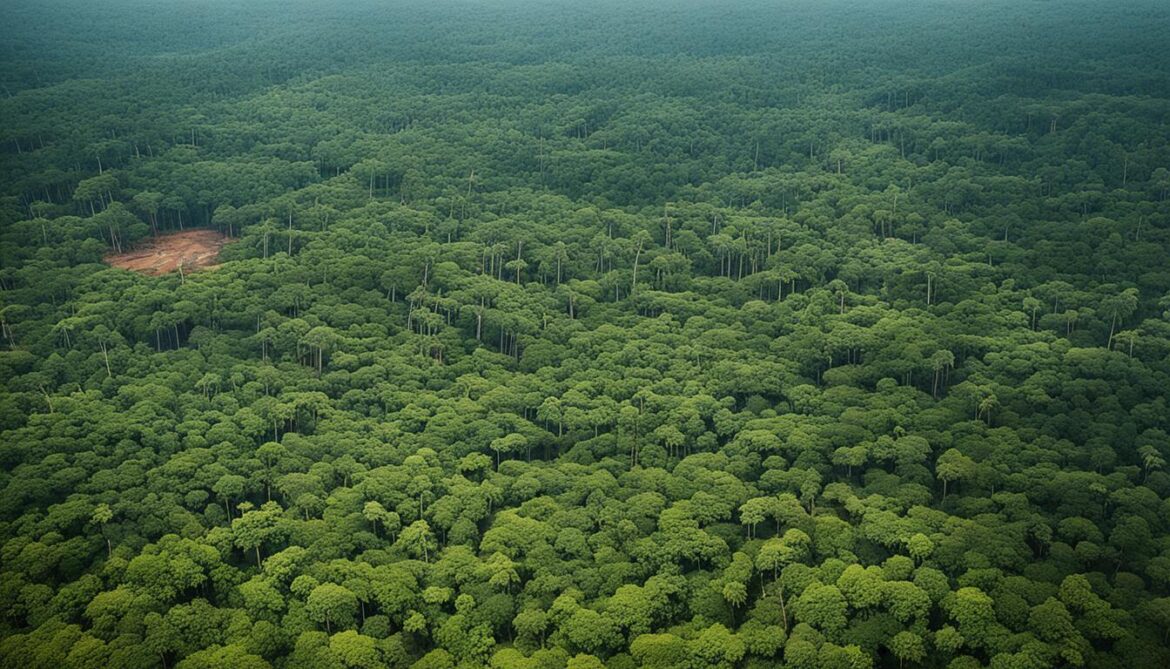
Conservation Efforts and Nature Reserves in Benin
Benin has made significant efforts to protect its rich biodiversity through the establishment of nature reserves and the implementation of conservation projects. These initiatives play a crucial role in preserving the country’s unique flora and fauna and promoting biodiversity conservation.
The W National Park
One of the noteworthy nature reserves in Benin is the W National Park, which is shared among Niger, Benin, and Burkina Faso. This transboundary park is renowned for its diverse range of plant and animal species. Spanning over 6,000 square kilometers, the park provides a sanctuary for numerous endangered and threatened species.
The Pendjari National Park
Another important conservation area in Benin is the Pendjari National Park. Located in the northwestern part of the country, this park features stunning hills and cliffs, creating a picturesque landscape. The Pendjari National Park is home to a variety of wildlife, including elephants, lions, cheetahs, and over 300 bird species.
The Significance of Sacred Forests
Benin also has a network of sacred forests, which hold great cultural and ecological value. These forests are considered sacred by local communities and play a vital role in biodiversity preservation. They serve as important habitats for endemic and endangered species, contributing to the overall balance of ecosystems in the region.
To enhance the effectiveness of these nature reserves and conservation projects, partnerships and collaborations with local communities, government agencies, and international organizations are essential. By working together, we can ensure the long-term preservation of Benin’s incredible biodiversity and create a sustainable future for both the environment and the people.
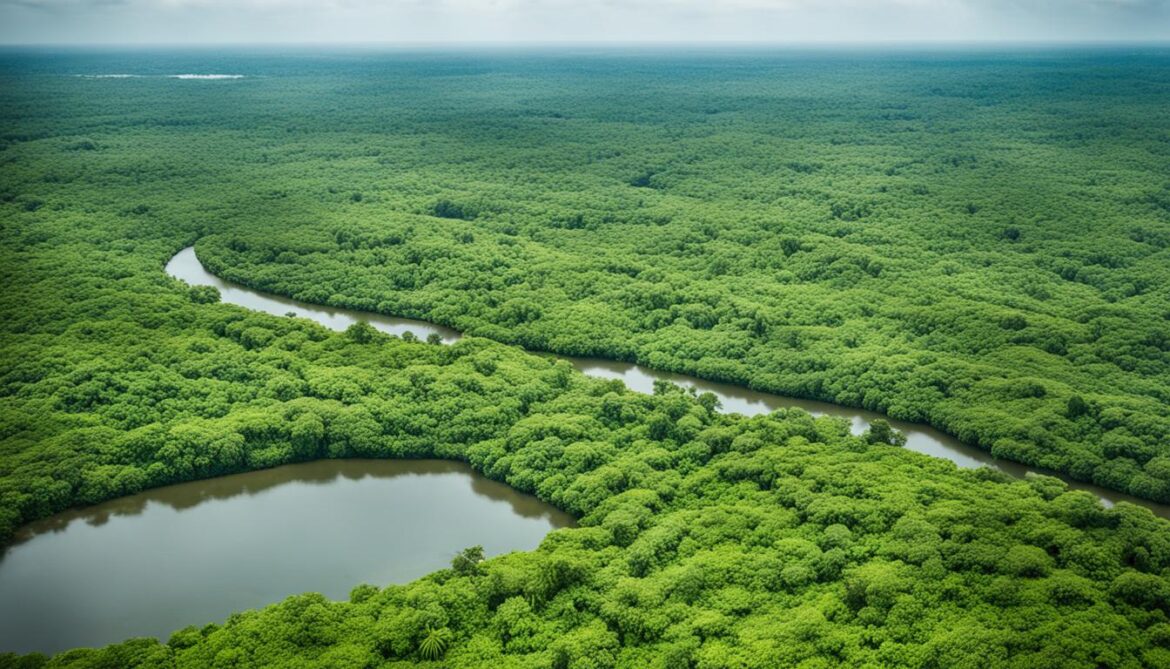
Traditional Building Techniques and Locally Sourced Materials in Green Building
Green building practices in Benin embrace traditional construction techniques that were developed to adapt to the local climate and environment. These techniques, such as mud and earth construction, are resource-efficient and low-carbon. Locally sourced materials like clay and straw are used to reduce the carbon footprint of construction and preserve traditional building methods.
Traditional building techniques in Benin have stood the test of time, providing sustainable and eco-friendly solutions for constructing homes, buildings, and infrastructure. These methods not only minimize the environmental impact but also promote the use of locally available materials, supporting the local economy and reducing transportation-related emissions.
Resource-Efficient Mud and Earth Construction
Mud and earth construction, commonly known as adobe or cob, is a traditional building technique that utilizes locally sourced soil mixed with water and organic materials like straw or grass. The mixture is then molded into bricks or applied as plaster to construct walls, floors, and roofs.
This technique is highly sustainable as it requires minimal energy inputs and relies on materials readily available in the surrounding areas. It also has excellent insulation properties, keeping the interior cool in hot climates and warm during cooler seasons.
By utilizing mud and earth as primary building materials, the need for energy-intensive manufacturing processes and carbon-intensive construction materials like cement and steel is significantly reduced.
Moreover, mud and earth construction helps to sequester carbon dioxide from the atmosphere, further contributing to reducing greenhouse gas emissions and mitigating climate change.
One notable example of mud and earth construction in Benin is the Royal Palaces of Abomey, a UNESCO World Heritage Site. These historic palaces showcase the durability and aesthetic appeal of traditional building techniques.
Locally Sourced Materials for Sustainability
Green building practices in Benin prioritize the use of locally sourced materials like clay, straw, and timber. These materials have a smaller environmental footprint compared to imported or manufactured alternatives.
Clay, abundant in Benin, is used for making bricks, tiles, and decorative elements. It is a versatile material that is durable, fire-resistant, and biodegradable.
Straw and other plant fibers are commonly employed as reinforcement in mud and earth construction, providing additional strength to the structures. These materials are renewable and biodegradable, making them a sustainable choice.
Timber, sourced from responsibly managed forests, is used for structural elements and finishes. The use of timber promotes sustainable forestry practices and reduces the carbon footprint associated with conventional building materials.
By utilizing locally sourced materials, green buildings in Benin not only reduce the carbon emissions associated with transportation but also support local artisans and traditional craftsmanship.
Traditional building techniques in Benin demonstrate the integration of cultural heritage, sustainability, and resource efficiency. By utilizing mud, earth, and locally sourced materials, green buildings in Benin celebrate the country’s rich cultural traditions while promoting environmentally friendly construction practices. These practices align with the principles of resource efficiency and low-carbon construction, contributing to the overall sustainability and resilience of Benin’s built environment.
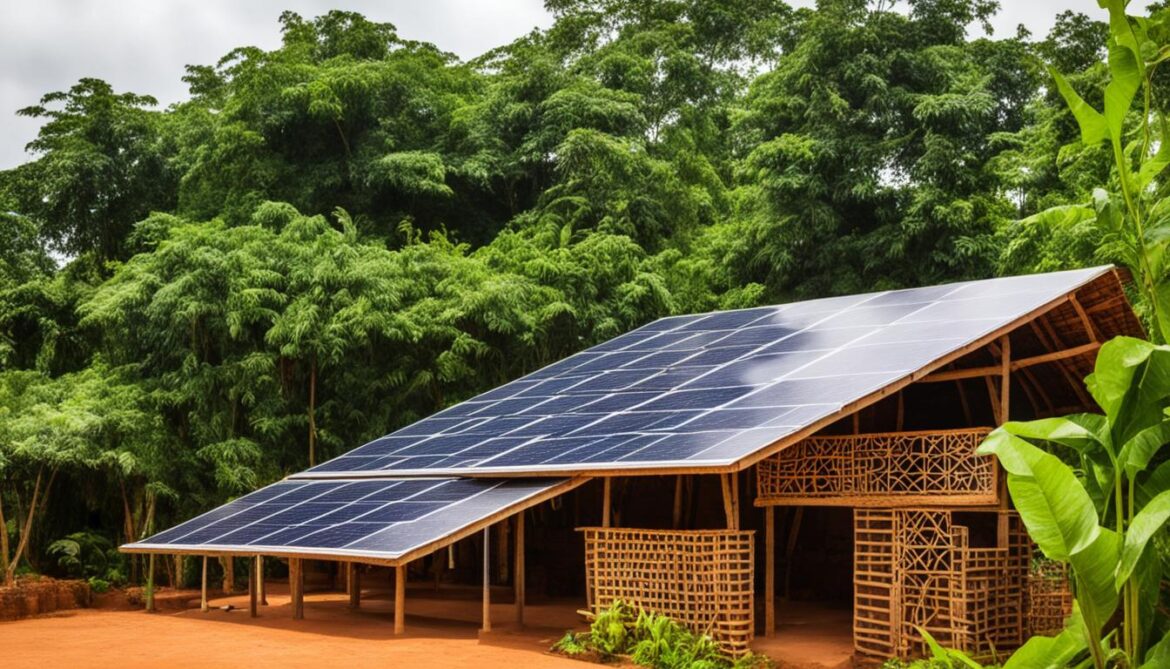
Image: Traditional mud and earth construction in Benin. Source: seowriting.ai
Natural Ventilation and Passive Cooling Strategies in Green Building
In Benin’s sustainable design principles, natural ventilation and passive cooling strategies are key components of green building practices. These strategies are aimed at creating comfortable indoor environments while reducing energy consumption and promoting energy efficiency.
Design principles for natural ventilation involve proper orientation of buildings to maximize airflow and harness natural breezes. Shading devices, such as overhangs and louvers, are used to control solar heat gain and prevent excessive heat buildup. These strategies minimize the need for mechanical cooling systems, resulting in lower energy consumption and reduced carbon emissions.
Passive cooling strategies in green building further enhance energy efficiency by utilizing natural elements and design techniques. Building materials with high thermal mass, such as adobe or stone, help regulate indoor temperatures by absorbing and releasing heat slowly. Roof insulation and reflective surfaces reduce heat transfer from the roof to the building, keeping interiors cool.
“By integrating renewable energy sources like solar panels into building designs, green buildings in Benin can further decrease their reliance on fossil fuel-based energy and achieve a more sustainable and environmentally friendly operation,”
These sustainable design principles in green building contribute to the overall energy efficiency of buildings, reducing the environmental impact and promoting a more sustainable future. By harnessing natural ventilation and passive cooling strategies, Benin’s green buildings prioritize occupant comfort while conserving resources and minimizing energy demand.
Benefits of Natural Ventilation and Passive Cooling Strategies in Green Building
The benefits of natural ventilation and passive cooling strategies extend beyond energy efficiency. They also contribute to improved indoor air quality, reduced reliance on artificial cooling systems, and cost savings for building owners over the long term. By embracing these sustainable design principles, Benin’s green buildings prioritize the well-being of occupants and the environment.
| Advantages | Benefits |
|---|---|
| Energy efficiency | Reduced energy consumption and carbon emissions |
| Improved indoor air quality | Natural ventilation promotes fresh air circulation |
| Cost savings | Lower operation and maintenance costs |
| Reduced reliance on mechanical cooling | Less dependence on artificial cooling systems |
| Sustainable design | Promotes eco-friendly construction practices |
By adopting natural ventilation and passive cooling strategies, Benin’s green buildings align with sustainable design principles, energy efficiency, and renewable energy sources, contributing to a greener and more sustainable built environment.
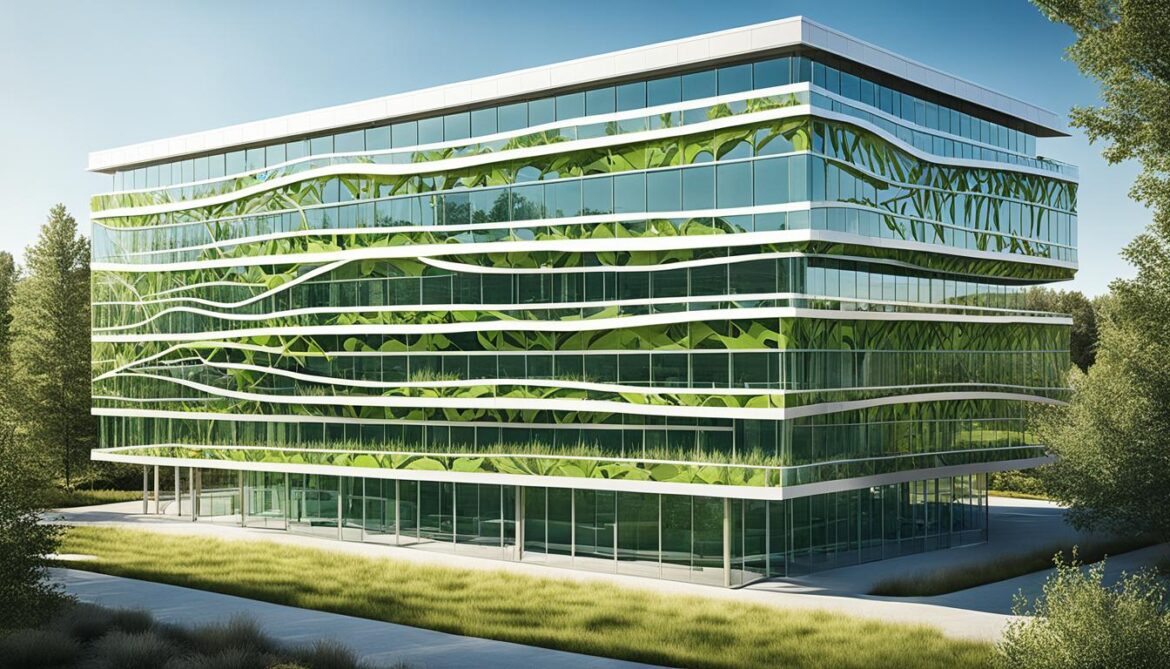
Water Conservation and Sustainable Water Management in Green Building
Water conservation plays a vital role in green building practices in Benin. With the country’s seasonal rain patterns and water scarcity, it is crucial to prioritize sustainable water use to ensure a reliable water supply. Two key strategies employed are rainwater harvesting systems and greywater recycling.
The Importance of Rainwater Harvesting Systems
“Rainwater harvesting is a sustainable solution that helps mitigate water scarcity and reduce reliance on external water sources,” says Dr. Amah Ayivi, an environmental scientist. “By capturing rainwater from rooftops and storing it for later use, buildings can reduce their demand for potable water.”
Rainwater harvesting systems collect and store rainwater runoff from the roofs of buildings. The collected water can be used for various non-potable purposes, such as irrigation, toilet flushing, and washing. By utilizing rainwater, green buildings can significantly reduce the strain on municipal water supplies and lower overall water consumption.
The Benefits of Greywater Recycling
Greywater recycling is another sustainable water management practice employed in green building projects. Greywater refers to wastewater from sinks, showers, and laundry, excluding sewage. Instead of being discharged into the sewage system, greywater can be treated and reused for non-potable purposes.
“Greywater recycling helps conserve water and reduces the burden on freshwater resources,” explains Dr. Ayivi. “With proper treatment, greywater can be safely used for irrigation, flushing toilets, and other non-drinking purposes.”
Greywater recycling systems filter and treat the greywater, making it suitable for reuse. This minimizes the demand for freshwater and reduces the strain on the municipal water supply. By implementing greywater recycling, green buildings can further promote sustainable water use and contribute to water conservation efforts.
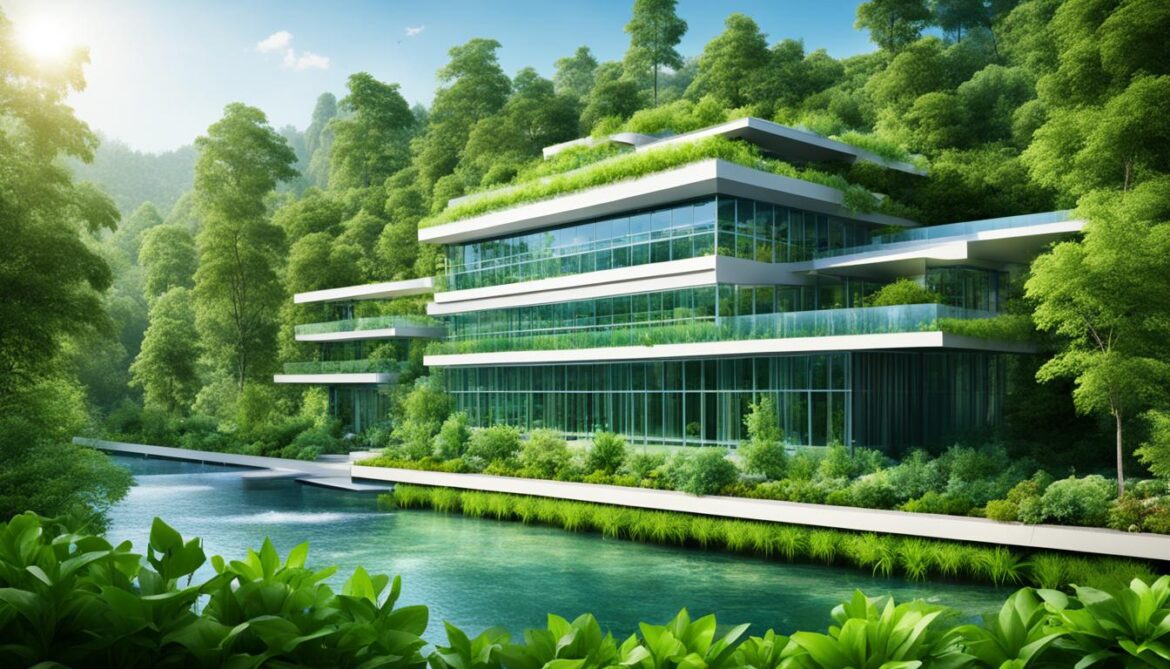
Sustainable Water Use in Green Building
By incorporating rainwater harvesting systems and greywater recycling, green buildings in Benin are able to achieve sustainable water use. These practices not only reduce the demand for potable water but also help preserve water resources by utilizing alternative water sources.
In addition to rainwater harvesting and greywater recycling, green building designs also focus on efficient water fixtures such as low-flow faucets and toilets. These fixtures minimize water wastage and contribute to overall water conservation.
Water Conservation Strategies in Green Buildings
| Water Conservation Strategy | Description |
|---|---|
| Rainwater Harvesting | Collection and storage of rainwater for non-potable use |
| Greywater Recycling | Treatment and reuse of wastewater from sinks, showers, and laundry |
| Efficient Water Fixtures | Installation of low-flow faucets and toilets to minimize water consumption |
By implementing these water conservation strategies, green buildings in Benin exemplify sustainable water management and contribute to the overall goal of preserving and safeguarding water resources.
Energy Efficiency and Government Support for Green Building
Energy efficiency and the use of renewable energy sources are key priorities in green building practices in Benin. By focusing on sustainable construction practices, the country aims to reduce environmental impact and promote a cleaner, greener future.
The Benin government has taken proactive steps to support green building initiatives and encourage sustainable design and construction. Through policies and initiatives, they are incentivizing the adoption of energy-efficient technologies and renewable energy solutions.
The Benin Green Building Council plays a crucial role in promoting sustainable practices and providing guidance to the construction industry. They advocate for energy-efficient building materials, sustainable design principles, and environmentally-friendly construction practices.
One of the major focuses in Benin’s green building efforts is increasing solar power production. Renewable energy sources such as solar panels are being integrated into building designs, reducing reliance on fossil fuels and decreasing carbon emissions.
To further support energy efficiency and sustainable construction practices, the government has implemented financial incentives, tax credits, and grants for green building projects. These initiatives aim to make sustainable building more accessible and affordable for developers and individuals who want to contribute to a greener future.
The Benin Green Building Council
The Benin Green Building Council (BGBC) is a key player in promoting sustainable construction practices in the country. Through educational programs, certification schemes, and partnerships with industry stakeholders, the BGBC aims to raise awareness and build capacity for green building practices.
“Green building practices are not only good for the environment but also for our economy and the well-being of our citizens. By prioritizing energy efficiency and renewable energy sources, we can create sustainable buildings that reduce operating costs, enhance comfort, and reduce greenhouse gas emissions.” – BGBC representative
As part of their efforts, the BGBC provides training and certification programs in energy-efficient design and construction. They also collaborate with architects, engineers, and developers to integrate sustainable practices into their projects.
Government Initiatives
The government of Benin has launched several initiatives to support energy efficiency and sustainable construction. These initiatives aim to create a favorable environment for green building practices and encourage the adoption of sustainable design principles.
Some of the government initiatives include:
- Financial incentives: The government offers financial incentives to developers who incorporate energy-efficient technologies and renewable energy sources into their projects. This includes grants and tax credits to offset the additional costs associated with green building.
- Capacity building programs: The government provides training programs and workshops to educate architects, engineers, and construction professionals about sustainable construction practices. These programs help to build the skills and knowledge required to implement energy-efficient designs.
- Regulatory support: The government has implemented building codes and regulations that promote energy efficiency and sustainable construction. These regulations ensure that new buildings meet energy performance standards and encourage the use of renewable energy sources.
The government’s support for green building is aligned with their commitment to sustainable development and environmental stewardship. They recognize the importance of reducing energy demand, minimizing carbon emissions, and preserving natural resources for future generations.
By prioritizing energy efficiency and renewable energy sources, Benin is paving the way for a more sustainable and environmentally-friendly construction industry.
Government Initiatives
| Government Initiatives | Description |
|---|---|
| Financial incentives | The government offers financial incentives, such as grants and tax credits, to developers who incorporate energy-efficient technologies and renewable energy sources into their projects. |
| Capacity building programs | The government provides training programs and workshops to educate architects, engineers, and construction professionals about sustainable construction practices. |
| Regulatory support | The government has implemented building codes and regulations that promote energy efficiency and sustainable construction, ensuring new buildings meet energy performance standards. |
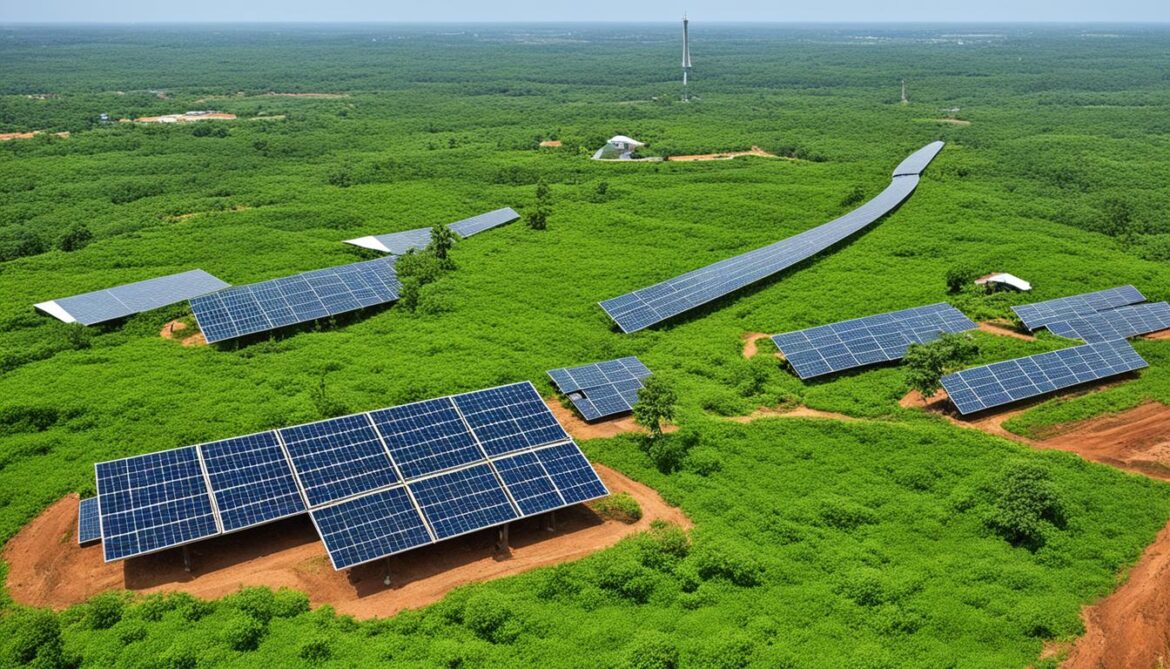
Existing Protected Area and OECM Commitments in Benin
Benin has made significant commitments to protect its biodiversity through the establishment of protected areas and the implementation of other effective area-based conservation measures. These initiatives demonstrate the country’s dedication to preserving its natural heritage and promoting sustainable development.
As part of its efforts, Benin has developed a national biodiversity strategy and action plan. This comprehensive framework provides guidance for the conservation and sustainable management of the country’s diverse ecosystems, ensuring the protection of valuable habitats and species.
Furthermore, Benin has successfully accessed funding from the Global Environment Facility (GEF) to support various projects aimed at protecting and managing its protected areas. These GEF-funded initiatives play a crucial role in enhancing the effectiveness of conservation efforts and promoting sustainable practices.
Protected areas in Benin encompass a wide range of ecosystems, including forests, wetlands, and coastal areas. These areas are designated to safeguard biodiversity, preserve critical habitats, and provide refuge for endangered species. Through the establishment and effective management of protected areas, Benin contributes to the global conservation agenda and demonstrates its commitment to the conservation of biological diversity.
In addition to protected areas, Benin also recognizes the importance of implementing other effective area-based conservation measures (OECMs). These measures focus on conserving biodiversity outside of traditional protected areas through sustainable land-use practices, community-based conservation initiatives, and the recognition of customary territories.
“By combining protected areas and other effective area-based conservation measures, Benin enhances its efforts to conserve biodiversity and strengthen the resilience of ecosystems.”
The implementation of protected areas and other effective area-based conservation measures is a vital component of Benin’s broader strategy for sustainable development. These initiatives not only preserve invaluable natural resources but also support local communities, promote environmental education, and contribute to the achievement of national and international biodiversity targets.
Through the ongoing commitments to protected areas, other effective area-based conservation measures, and the support of GEF projects, Benin continues to demonstrate its dedication to biodiversity conservation and the promotion of sustainable development.
Conclusion
Benin places great importance on the preservation of its rich biodiversity and has made significant strides in protecting its natural heritage. Conservation efforts, through projects, nature reserves, and the adoption of green building practices, are integral to promoting sustainable development and maintaining ecological balance in the country.
Continued dedication and awareness about the significance of biodiversity preservation are crucial for the future of Benin’s environment and communities. By supporting initiatives that focus on the Benin Biodiversity and the Built Environment, the country can ensure the long-term protection of its diverse ecosystems and the sustainable development of its urban areas.
Through ongoing efforts, Benin can sustain a harmonious relationship between its built environment and the natural world, fostering a thriving ecosystem that benefits both present and future generations. By prioritizing conservation and embracing sustainable practices, Benin sets a powerful example for other nations striving to strike a balance between development and environmental stewardship.
FAQ
What is the Benin Biodiversity and the Built Environment?
The Benin Biodiversity and the Built Environment refers to the relationship between the country’s rich biodiversity and sustainable architecture design and urban planning practices aimed at preserving and protecting the environment.
What are some conservation projects in Benin?
Benin has implemented various conservation projects, including the establishment of nature reserves such as the W National Park and the Pendjari National Park, as well as initiatives to protect sacred forests and their biodiversity.
How does green building contribute to biodiversity preservation?
Green building practices in Benin prioritize resource-efficient and low-carbon construction techniques. The use of traditional building techniques and locally sourced materials helps preserve biodiversity by reducing the carbon footprint and conserving natural resources.
What strategies are used in green building to achieve energy efficiency?
Green building in Benin focuses on natural ventilation and passive cooling strategies. Proper orientation and shading devices are employed to maximize natural airflow and minimize reliance on mechanical cooling systems, leading to energy efficiency and reduced carbon emissions.
How does green building promote water conservation in Benin?
Green building practices in Benin include rainwater harvesting systems and greywater recycling to reduce the demand for potable water. These strategies help conserve water resources, mitigate water scarcity, and minimize pollution.
How is the government supporting green building in Benin?
The government of Benin has implemented policies and initiatives to encourage sustainable construction. The Benin Green Building Council promotes sustainable design and construction practices, while the country focuses on increasing solar power production and reducing reliance on fossil fuels.
What commitments has Benin made to protected areas and conservation measures?
Benin has committed to protected areas and other effective area-based conservation measures. The country has developed a national biodiversity strategy and action plan and implemented various projects funded by the Global Environment Facility (GEF) to protect and preserve biodiversity.
Why is it important to preserve Benin’s biodiversity?
Preserving Benin’s biodiversity is crucial for maintaining ecological balance, protecting rare and endemic species, and ensuring sustainable development. It contributes to the country’s natural heritage and the well-being of its communities.



